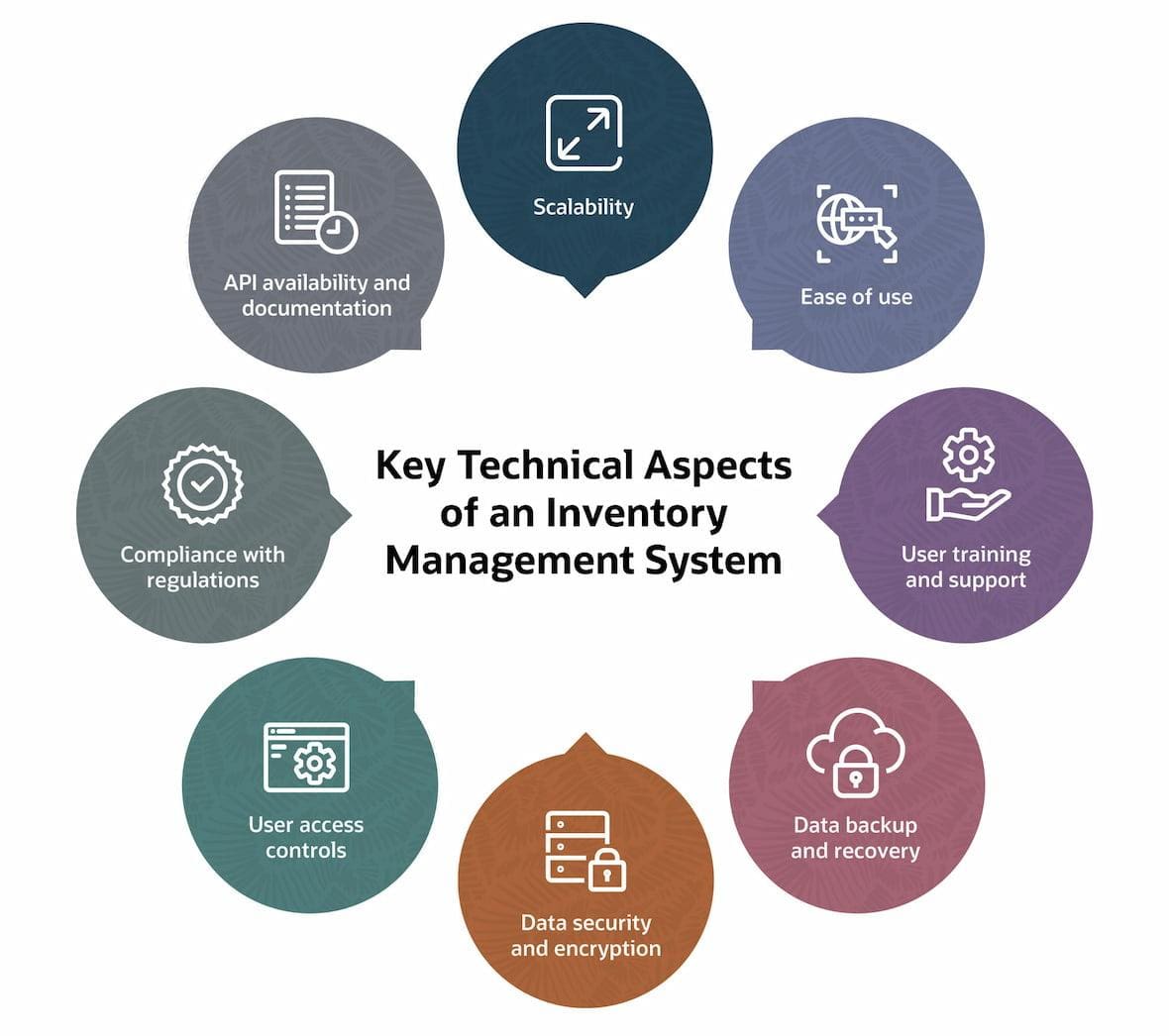Inventory management is a complex endeavor, involving a balance of accurate forecasting, efficient stock control, timely order fulfillment and strategic purchasing decisions to optimize costs and meet customer demands. Any errors during the process can have serious consequences. A study by packaging company Avery Dennison indicates that 8% of global stock perishes or is discarded annually. That’s $163 billion of wasted inventory each year — more than the gross domestic product of Croatia, Costa Rica and Iceland combined.
As with many business challenges, technology can help. In this case, inventory management systems can automate and manage stock levels, orders, sales and deliveries to strengthen inventory control and supply chain operations. This article helps guide the selection process for inventory management systems, offering a comprehensive look at key features, as well as tips for building thorough assessments.
What Is an Inventory Management System?
An inventory management system oversees and adjusts the flow of goods with precision to avoid costly stockouts and overstock scenarios for either manufacturers or retailers. It verifies that every product is in place, just in time, streamlining operations, while minimizing costs and delighting customers. An inventory management system also provides valuable insights into inventory trends, helping forecast demand more accurately and fortifying purchasing decisions. And when this system is integrated with other business systems, such as accounting and order management, a business can achieve a reliable and holistic view of operations.
Key Takeaways
- If inventories aren’t managed well, companies can be caught carrying either too much or too little, which can have serious financial consequences, not to mention possible customer service issues.
- Companies use inventory management systems to track inventory levels, orders, sales and deliveries so they can optimize and streamline their inventory management process.
- Requirements for inventory management systems often vary. Smaller companies with fewer products often look for simpler systems that focus on avoiding excess inventory, while larger companies look for scalable systems with features like demand forecasting, multilocation tracking and detailed analytics.
- Companies evaluating inventory management systems should consider technical features, such as scalability and ease of use, as well as cost, scalability, security and straightforward implementation and integration.
Understand Your Inventory Needs
To select the right inventory management system, companies must first understand the specific inventory challenges they need to solve, which often vary based on the size of the company. Here’s how to evaluate needs and challenges.
-
Assess Business Size and Type
The size and type of a company profoundly influence its inventory needs, shaping the complexity, scope and features required of an inventory management system. For small businesses, for example, simplicity and cost-effectiveness often take precedence. As a result, they might prioritize systems that don’t require complex integrations and that focus on making sure enough products are on hand to fulfill orders without overstocking. In contrast, large enterprises, such as multinational manufacturers, often have complex supply chains, diverse product lines and multiple storage locations. These conditions demand a robust inventory management system with features like demand forecasting, multilocation tracking and detailed analytics. The scalability of the system must also align with a business’s growth trajectory. A growing midsize business, for example, might soon outgrow a system suited for small businesses, prompting a costly and disruptive upgrade.
The type of business further influences inventory management needs. For example, a seasonal retailer that experiences highs and lows in demand may require a system equipped with trend analysis and forecasting to avoid overstocking in the off-season. A perishable goods supplier, on the other hand, may benefit from detailed tracking of expiration dates and batch numbers to prevent losses.
-
Identify Key Inventory Challenges
Simply put, understanding inventory challenges helps companies select an inventory management system that aligns capabilities with specific needs. For instance, a retail business might struggle with discrepancies between recorded inventory and actual stock, leading to overstocking or stockouts. As a result, it’ll likely need a system with robust real-time tracking and alert capabilities. Larger businesses, especially those dealing with seasonal fluctuations or rapidly changing markets, may struggle to predict market trends and customer preferences, which puts a premium on inventory management systems with advanced analytics and trend-prediction features. Another frequent issue: Companies offering a wide range of items, each with a different turnover rate, can find it difficult to maintain optimal stock levels.
To identify inventory management needs, companies should conduct a thorough analysis of their supply chain processes and seek feedback from various departments, such as sales, purchasing and warehouse management, to pinpoint inefficiencies and common concerns. Also, reviewing historical inventory data and performance metrics can help reveal trends and areas that need improvement.
Inventory Management System Features
The following list of key inventory management system capabilities divides features into two segments: core capabilities, which should be part of any comprehensive solution, and advanced features that may be appeal to more complex organizations. The list also highlights specific ecommerce features.
-
Core Features
The following features are considered staples of a modern inventory management system. Some characteristics might take priority over others during the vendor-selection process, depending on the size and type of organization evaluating them.
- Real-time inventory tracking: With real-time inventory tracking, businesses gain instant visibility into their stock levels, transactions and movements. This can prevent stockouts and overstocking, optimize order fulfillment and sharpen decision-making through availability of accurate, timely data. Real-time inventory tracking also streamlines operations by automating manual inventory counts and minimizing errors.
- Automated reordering: Carrying too much or too little inventory has serious financial repercussions for companies, including increased holding costs, lost sales due to stockouts, reduced cash flow and potential damage to customer relationships. Automated reordering can prevent this situation by predicting and initiating purchase orders for stock replenishment based on predefined criteria, such as minimum stock levels, sales velocity and lead times.
- Order management: As companies grow and handle ever more complex transactions across multiple channels, order management helps streamline and coordinate the entire process, from order placement to product delivery. It automates and centralizes order tracking, inventory levels and customer information to facilitate accurate and timely fulfillment. The result is improved customer satisfaction, reduced errors and increased operational efficiency.
- Reporting and forecasting tools: Reporting and forecasting tools become essential as companies expand and market demands fluctuate. Reporting tools provide detailed insights into sales trends, inventory levels and order history, allowing businesses to analyze performance and identify inefficiencies. Forecasting tools use historical data and market trends to predict future demand, optimize inventory levels and prevent inventory excesses or shortfalls.
- Supplier management: Supplier management helps preserve a steady, cost-effective amount of quality goods as companies expand operations and product portfolios. The supplier management feature of an inventory management system allows businesses to track and evaluate supplier performance, manage contracts and negotiate terms, all in a single application. This results in improved supply chain reliability, better cost control and stronger relationships with suppliers.
- Product information management: Expanding product portfolios also make it critical for companies to manage detailed information about each item to ensure accuracy and consistency across sales channels. Many inventory management systems have product information management features that centralize and organize all product data, including descriptions, specifications and pricing, to simplify updates and access. Accurate, comprehensive product information improves product listings and updates, while enhancing both the customer experience and decision-making.
- Integration capabilities: Integrating inventory management systems with other business applications, such as accounting, customer relationship management (CRM) and ecommerce platforms, streamlines processes, limits manual data entry errors and boosts real-time visibility across operations. For example, integrating an inventory management system with an accounting platform can automatically update financial records with each purchase for accurate financial reporting and timely tax preparation.
-
Advanced Features
When evaluating inventory management systems, larger companies with broader product portfolios and multiple warehouses may find the following features worth reviewing.
- AI-driven forecasting: Artificial intelligence (AI) tools are redefining how inventory management systems predict future demand and trends. These tools analyze large volumes of historical and real-time data, using advanced algorithms to identify patterns and predict future inventory needs. The results are improved forecast accuracy, reduced risk of stockouts or overstock, optimized inventory levels and greater ability to respond proactively to market changes.
- RFID technology: Radio-frequency identification (RFID) uses
radio waves
to facilitate communication between a tag, which is attached to an object, and a
reader.
In inventory management, RFID tools enable real-time, automated tracking of
inventory
items. This produces instant, accurate inventory counts, location tracking and
efficient
movement of goods through the supply chain. It also cuts down manual errors and
bolsters
security.
- Batch and expiry date tracking: For products with a limited
shelf life,
such as food, pharmaceuticals and chemicals, batch
and expiry date tracking features ensure that items are sold or used
before they
spoil or become ineffective. These advanced features monitor and manage
inventory in
batches, tracking when items were produced and when they expire, and
automatically
trigger alerts when products near their expiry date. This reduces waste,
increases
safety and compliance and builds customer trust.
- Cross-docking and drop-shipping management: Cross-docking and drop-shipping management tools organize and shuttle incoming goods from suppliers directly to outgoing trucks. Cross-docking involves transferring products received at a warehouse’s incoming dock to an outgoing dock, bypassing long-term storage. Drop-shipping allows retailers to transfer customer orders directly to suppliers for fulfillment. This streamlines supply chains, reduces delivery times, lowers storage and handling costs and allows companies to offer a wider variety of products without holding inventory.
-
Ecommerce Features
The features listed below are particularly helpful for companies that engage in ecommerce, although they may also have value for any company with advanced inventory needs.
- Multichannel integration: Businesses today often use multiple
distribution channels to promote and distribute their products, from online
marketplaces
and physical stores to social media platforms. Multichannel integration within
an
inventory management system allows businesses to synchronize inventory data
across all
channels, which streamlines inventory tracking and prevents overstocking or
stockouts.
It also provides consistent information on product availability to customers and
optimizes sales opportunities by adjusting inventories to accommodate shifts in
demand
across channels.
- Returns management: Product returns are a common occurrence for
almost
any business. Returns management features, such as reverse
logistics, streamline
the process of tracking returned
items, updating inventory levels accordingly and managing refunds or exchanges.
Returns
management tools encourage customer satisfaction by facilitating a smooth
returns
process while also providing valuable data to businesses for analyzing returns
trends
and improving inventory accuracy.
- Real-time shipping and tracking information: These capabilities
allow
an inventory management system to provide the business and its customers with
immediate
updates on the status of shipments. They closely monitor the delivery process to
facilitate better logistics management and timely intervention should stock
issues
arise. For customers, real-time shipping and tracking provide transparency and
peace of
mind, improving overall customer experience and trust.
- Demand-driven replenishment: Companies in fast-moving consumer
goods,
ecommerce, fashion retail and technology sectors often require rapid response to
changing consumer preferences and market trends. Demand-driven replenishment
continuously analyzes real-time sales and market data to adjust inventory levels
dynamically, helping to avoid overstocks and stockouts. This increases
operational
efficiency, minimizes storage costs and ensures product availability, as well as
satisfied customers.
- Customer behavior analytics: The more businesses understand
customer
behavior, the more they can tailor inventory to meet customer demands
effectively,
personalize marketing efforts and enhance the overall customer experience. With
customer
behavior analytics, businesses can understand and predict purchasing patterns by
analyzing data on customer interactions and transactions, a crucial ingredient
for any
business facing highly competitive markets and fluctuating consumer
preferences.
- Mobile accessibility: Most employees today are on the go,
either due to
working remotely or traveling for business. The mobile accessibility features in
an
inventory management system are critical for users who need to access, update
and manage
inventory data in real-time from anywhere, using their mobile devices. These
features
grant operational flexibility, improve data accuracy through real-time updates
and
enable quicker decision-making.
- Multichannel integration: Businesses today often use multiple
distribution channels to promote and distribute their products, from online
marketplaces
and physical stores to social media platforms. Multichannel integration within
an
inventory management system allows businesses to synchronize inventory data
across all
channels, which streamlines inventory tracking and prevents overstocking or
stockouts.
It also provides consistent information on product availability to customers and
optimizes sales opportunities by adjusting inventories to accommodate shifts in
demand
across channels.
Technical Aspects of an Inventory Management System
In addition to providing comprehensive capabilities, inventory management systems must be built on a platform that can adapt to a company’s current inventory needs, as well as its future requirements. Carefully considering the following technical aspects of an inventory management system can help companies determine how a solution might fit within their overall IT ecosystems.

- Scalability: Companies poised for growth need a scalable
inventory
management system that adapts seamlessly to calls for increased inventory,
additional
product lines or expanded operational needs. When evaluating solutions,
companies should
weigh potential future growth scenarios, such as entering new markets or
increasing
product diversity. They should be sure that whatever system they choose can
handle such
changes without requiring a complete overhaul to protect investments and support
business growth.
- Ease of use: Ease of use in an inventory management system
directly
impacts the efficiency and productivity of employees that manage inventory. A
user-friendly system minimizes training time, reduces errors and facilitates
quick
adoption across various levels of technical expertise. Companies should consider
a
system’s interface intuitiveness, ability to perform common tasks, and the
availability
of customer support and training resources from the provider.
- User training and support: For an inventory management system
to
improve efficiency and productivity, all users must feel motivated to use it to
its
fullest potential. Solid training flattens the learning curve and reduces
operational
errors. In addition, robust support from a software provider guarantees ongoing
assistance with troubleshooting and system updates. Companies should look for
comprehensive training programs covering multiple support channels, such as live
chat
and by phone. In addition, resources like tutorials or user guides assist with
seamless
integration and continuous operation of the system.
- Data backup and recovery: Data backup and recovery features are
vital
parts of any software product to help safeguard against data loss due to system
failures, cyberattacks or human error. In an inventory management system, these
features
maintain the integrity and availability of important inventory data, preventing
financial losses, compromised customer service and even reputational damage.
Businesses
should consider systems that perform regular, encrypted backups, verify the
backups’
resilience against data breaches and ensure swift, reliable data restoration
that
supports specific risk management protocols and operational needs.
- Data security and encryption: Protecting sensitive information
from
unauthorized access and potential breaches is paramount in an era where data is
a vital
asset. Strong data security measures, including robust encryption protocols, can
safeguard inventory details that, if leaked, could lead to operational chaos.
For
example, if inventory records are tampered with, supply chains and sales
processes can
be disrupted. Companies must examine the encryption standards of any solution,
the
system’s adherence to data protection regulations and its track record in
thwarting
cyberthreats.
- User access controls: User access controls ensure that
sensitive data
is accessible only to authorized personnel, thus mitigating the risk of data
breaches
and internal fraud. Role-based access to data strengthens security protocols and
maintains operational integrity by assigning appropriate levels of data
interaction to
different users. When choosing an inventory management system, companies should
scrutinize the granularity of permissions settings, the simplicity of modifying
access
rights and a system’s ability to provide audit trails for user activities to
trace
accountability and guarantee compliance.
- Compliance with regulations: Inventory data often includes
personal
information related to customers or suppliers, such as names, addresses and
purchase
histories. To avoid fines, penalties or legal action, it’s necessary for
companies to
choose an inventory management system that adheres to various regulatory
requirements,
provide necessary reporting formats and facilitate audit trails for transparency
and
accountability. Some of the compliance standards an inventory management system
might
address include General Data Protection Regulation (GDPR), the Sarbanes-Oxley
Act, and
health and safety standards for inventory handling and storage
data.
- API availability and documentation: Application programming interfaces (APIs) extend the functionality of an inventory system by allowing customized connections with other core business applications, such as CRM software, ecommerce platforms or accounting tools. Not only does this enhance efficiency, but it also provides a more comprehensive view of operations. Companies should consider the breadth of API integrations available in any inventory management solution, as well as the clarity and depth of the documentation provided and the level of technical support offered.
Cost Considerations
Cost should never be the sole factor when choosing an inventory management system, but understanding the following criteria can help ensure that the system will be worth the investment.
-
Understanding Pricing Models
Providers of inventory management systems typically offer several pricing options, including subscription-based, per-user, per-transaction or one-time purchase models. Subscription-based models are common for cloud-based software, where providers host, manage and maintain the software themselves. Customers are typically charged a recurring monthly or yearly fee to access the system, using a browser. This can be beneficial for companies seeking predictable costs and continuous updates without any significant initial investment. Per-user pricing is also common with cloud-based software and allows for scalability, although it can become costly as a company grows and adds more users. Per-transaction models are less common but may work well for businesses with low transaction volumes. However, they can become unpredictable as companies scale. The one-time purchase model is typical for on-premises software, where customers host, manage and maintain the system themselves. However, this can involve significant up-front costs for hardware and IT resources to implement, customize and maintain the system.
Companies should plan for total cost of ownership (TCO) assessments to evaluate pricing models by analyzing all direct and indirect costs associated with an inventory management system over its expected life span. These costs include the initial purchase price and those for implementation, training, support and any future upgrades. Companies should also scrutinize possible hidden fees, such as those for additional users, support or updates, and consider the flexibility of the model if business needs change.
-
Return on Investment (ROI)
Calculating ROI helps companies quantify the efficacy of their software investments in terms of increased efficiency, cost savings, error reduction and improved customer satisfaction. ROI calculations consider the value of quantifiable benefits, like inventory cost reductions, as well as intangible benefits, such as improved data analytics.
The value of the benefits is then weighed against all the direct and indirect costs of the system over a defined period. Direct costs include hardware, software and subscription fees, implementation costs, ongoing maintenance and support expenses, training fees, and the cost of any upgrades during the system’s life cycle. Indirect costs include potential downtime during implementation or lost productivity due to learning curves for the new system. The higher the value of the benefits compared to the costs, the more likely the investment will prove to be a wise choice.
Security and Compliance
At first glance, inventory management systems might not seem particularly attractive to cybercriminals, but the truth is, they carry an abundance of critical supply chain information that could wreak havoc on production if it were to fall into the wrong hands. Companies should assess the following factors when evaluating security and compliance features of an inventory management system.
-
Data Security
Inventory management systems typically contain details about products, suppliers, customers, transaction records and sometimes financial data. A data breach can lead to significant consequences, including financial loss, legal repercussions, damage to the company’s reputation and competitive disadvantages if proprietary information is exposed.
Businesses should look for inventory management systems that adhere to industry-standard encryption protocols, such as the advanced encryption standard, secure sockets layer and transport layer security, as well as features for multifactor authentication, regular security audits and compliance with data protection regulations like GDPR. Other important security features include robust encryption for data at rest and in transit, access controls to ensure that only authorized personnel can view or modify sensitive data, and regular security updates to protect against new threats.
-
Disaster Recovery and Backup
Unforeseen events, such as system failures, cyberattacks and natural disasters, can leave a business vulnerable to inventory data loss, which can lead to operational disruptions, financial losses and damaged customer relationships. Backup and recovery systems safeguard against the unexpected to maintain the resilience and reliability of supply chain operations.
Ideally, companies should look for inventory management systems that provide automated and frequent data backups, preferably stored in a secure, off-site location or cloud environment to protect data from physical harm. Additionally, companies should prioritize systems that allow for rapid and complete data recovery, ensuring minimal operational downtime — and cost — in case of a disaster. Finally, systems with clear, straightforward procedures for data recovery make sure that, in the event of a disaster, the path to resuming normal operations will be as smooth and swift as possible.
-
Data Privacy
Inventory management systems often contain sensitive information that, if compromised, could lead to significant business and reputational damage. Details about products, suppliers and customers, including names, addresses and transaction histories, are attractive targets for cybercriminals. A lack of data privacy features in an inventory management system can expose companies to risks, including identity theft, financial fraud and breaches of customer trust. This deficit can also result in noncompliance with regulations, such as GDPR, leading to hefty fines and legal complications.
When evaluating data privacy features, businesses should opt for systems with strong encryption for data at rest and in transit, access controls limiting data visibility to authorized personnel and compliance with relevant data protection laws. Features like regular privacy audits, data anonymization capabilities and clear data handling policies are also important to make sure sensitive data is protected from external threats and properly used and managed internally to align with legal and ethical standards.
-
Audit Trails and Reporting
Audit trails in inventory management systems track and document every action taken within the system, such as inventory adjustments, order processing and user activities, creating a clear and chronological record that provides transparency, accountability and compliance. Without these features, companies may struggle to detect errors, fraud or mismanagement. Inventory management systems also typically feature reporting tools that transform data into actionable insights for strategic decision-making, such as inventory planning and management, and for compliance purposes.
Essential audit and reporting features to look for in an inventory management system include real-time tracking of all inventory-related activities, user-specific audit details and comprehensive reporting tools that offer insights into inventory performance, sales trends and supply chain efficiency.
Vendor Selection and Support
The tips outlined below can help companies construct thorough vendor comparisons. It’s not just about features, however; companies also should be sure to compare how each provider supports its product through customer service and user training.
-
Researching and Comparing Vendors
The sheer variety of features, pricing models, scalability and support offered by inventory management system vendors demands a thorough evaluation to align specific operational needs with budgets and long-term business strategy.
Key steps in the process include defining the specific requirements of the business, such as inventory volume, integration with other systems and specific features like real-time tracking or reporting capabilities. It’s also important to assess vendor reputation, customer testimonials and after-sales support services. Companies should request demonstrations or trials to evaluate usability and effectiveness in a real-world setting. A common pitfall in the selection process is focusing solely on cost, rather than on the total value offered by the system. For example, a cheaper option might lack crucial features or scalability, leading to higher costs in the long run.
-
Post-Purchase Support
Another common mistake in evaluating inventory management system vendors is overlooking the importance of vendor support and training services. Comprehensive support, which includes technical assistance, software updates, training for new features and guidance in system optimization, can significantly impact a system’s long-term usability and a company’s operational continuity.
It’s important for software vendors to provide a knowledgeable and responsive support team, as well as access to comprehensive training materials and a clear process for addressing technical issues. Businesses are advised to seek vendors that offer multiple support channels, such as phone, email and live chat. Additionally, regular software updates and proactive communication about new features or changes are essential for maintaining system relevance and performance.
Implementation and Integration
Inventory management systems often require integration with other business applications, such as accounting systems, making it important to build a thorough implementation plan that avoids costly disruptions and downtime. The following tips can ensure success.
-
Planning the Implementation Process
Implementing an inventory management system requires meticulous planning, coordination and customization to align the system with specific business workflows and objectives, such as optimizing stock levels, streamlining order fulfillment processes and integrating real-time data across sales and supply chain platforms.
The implementation planning process starts with identifying clear goals and requirements for the system, mapping out existing inventory processes, spotting areas for improvement and setting clear timelines. In the execution phase of implementation, the system is configured, data is migrated and integration with other business tools, such as CRM or accounting software, occurs. Data migration, where current inventory data is mapped and moved into the new system, is important for a successful implementation. Inaccuracies in data migration can incur issues with inventory tracking and order fulfillment, as well as disruptions in daily operations. The final phase of implementation is training and testing, where employees learn the new system and conduct testing to address snags and confirm functionality before full deployment.
-
Integration With Other Systems
Most companies implementing inventory management systems seek to integrate them with other critical business applications, including ERP, CRM software, ecommerce platforms, accounting systems and supply chain management tools such as supply and demand planning. Synchronizing inventory data with sales and customer information, for example, creates streamlined supply chain operations and increases financial accuracy.
Successful integration begins with identifying the specific systems that need to be connected and mapping out how data will flow among them. The second phase involves customizing the integration to align with specific business processes and requirements necessary to maintain seamless data synchronization and consistency. Maintaining data integrity is especially important during the implementation process. For instance, poor planning during integration of an inventory management system with an existing ecommerce platform could result in inaccurate product data and stock levels on a website.
Integrations of any kind are often complex. Failing to adequately test the integrated system before full deployment and neglecting ongoing maintenance could result in costly disruptions to the system. To avoid these pitfalls, companies should rely on thorough planning and extensive testing in a controlled environment. Access to ongoing technical support is equally vital.
Optimize Inventory Levels and Boost Profitability With NetSuite
NetSuite Inventory Management offers a versatile and comprehensive cloud-based solution for inventory management that caters to the needs of diverse businesses by streamlining operations, optimizing stock levels and providing visibility across multiple channels.
NetSuite ERP’s integrated approach to inventory management combines inventory capabilities with seamlessly connected modules for financial management, customer relationship management and ecommerce. This delivers a unified view of operations that improves efficiency and reduces the likelihood of errors. The system also includes capabilities for demand planning, which forecasts inventory needs based on historical data and sales projections, and warehouse management, which improves inventory handling and storage. The result is reduced carrying costs, minimized stockouts and overstocks and greater order fulfillment accuracy. NetSuite’s real-time data analytics capability also provides actionable insights for decision-making, and its scalable platform supports growth and adapts to changing business needs. And, with 100% cloud-based deployment, NetSuite offers accessibility from anywhere, so businesses can manage their inventory in real-time, regardless of employees’ physical location.
Choosing the right inventory management system can have a significant impact on operational efficiency and success. But the “right” system hinges on a company’s specific needs. That’s why it’s important to evaluate various system features and capabilities, with a keen eye toward the specific problems the system must solve. Just as important, companies must remember that the ideal inventory management system is one that not only meets current requirements, but also adapts and grows with the business.
Award Winning
Cloud Inventory
Free
Product
Tour(opens in a new tab)
Choosing an Inventory Management System FAQs
What is the best type of inventory management system?
The best type of inventory management system varies according to a company’s specific needs, size and industry. Small businesses, for example, may opt for a simple, user-friendly system that focuses on basic stock-level tracking and order management. Larger enterprises or those with complex supply chains, on the other hand, might require more advanced systems, with features like real-time analytics, multichannel integration and automated demand forecasting. Companies should choose a system that aligns with their operational processes and scalability requirements.
How do I choose an inventory management system?
To choose an inventory management system, first identify your specific business needs and challenges, such as tracking inventory levels, order management or integration with other software. Evaluate systems based on features, scalability, ease of use and compatibility with your existing processes and technology. Consider a system’s total cost of ownership, including setup, training and ongoing support. Lastly, read reviews, request demos and seek recommendations to ensure that the system aligns with your business goals and operations.
What are the four types of inventory management systems?
There are four primary methods of inventory management. Just-in-time systems minimize stock on hand by ordering just before use. First-in, first-out is a method where the oldest stock is sold first. Last-in, first-out sells the most recently produced items first. Finally, ABC analysis categorizes and manages items based on three categories that reflect their importance, price and sales volume.
What are the five types of inventory management?
The five main types of inventory are raw materials; work-in-process (WIP); finished goods; maintenance, repair and operating (MRO) supplies; and safety stock. Raw materials are the basics used to produce goods, while WIP represents partially completed products. Finished goods are ready for sale, and MRO supplies include items used in production but not part of the final product. Finally, safety stock serves as a buffer against supply chain disruptions.









